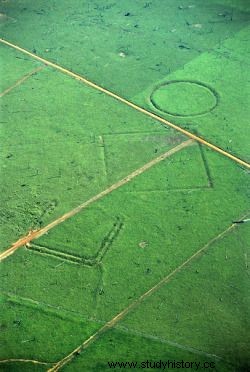Huge geometric figures have been found in the Amazon rainforest, but it is not known what these constructions were really intended for, used between 2000 and 650 BC.

Hundreds of enigmatic formations have been revealed during aerial overflights in the state of Acre, in the Amazon.
Circular, quadrangular, with ditches or raised… hundreds of mysterious enclosures have been discovered in the Amazon rainforest, in Brazil. Imposing, made up of trenches sometimes reaching up to 11m wide, and a depth of 4m, 450 of these strange earthworks from 100m to 300m in diameter, have been found in recent years, scattered over more than 13,000 km2 in the state of Acre, in the western Amazon. Collateral effect of deforestation, these hitherto unknown formations that intrigue specialists so much had for centuries been hidden under the emerald canopy, engulfed under the vegetation cover. Uncovered by modern deforestation, aerial overflights and the use of drones revealed its existence to a team of Anglo-Brazilian researchers. In an article published in the Reports of the American Academy of Sciences (PNAS), Jennifer Watling, from the Museum of Archeology and Ethnography of the University of Sao Paulo (Brazil), the anthropologist behind this publication, thus returns to the analysis of two of these sites. This is "Jaco Sé and "Fazenda Colorada » unveiled thanks to the recent clearings. Because of their scale on the ground, scientists have decided to call these creations "geoglyphs" even though they have nothing to do with the famous figures of Nazca (Peru) and Chile to which these terms are usually attributed.

For centuries, these mysterious enclosures had been concealed by forest cover. ©Diego Gurgel
This study confirms that these huge enclosures are the work of prehistoric populations who had already considerably transformed large areas of jungle to do so. Proof that the Amazon forest ecosystem was not as "pristine" as imagined. Indeed, as pristine and impenetrable as they appear to us today, not all so-called "primary" forests would be so pristine, as this work precisely indicates. Their structure and floristic composition would even constitute a sort of "historical tracer" where it would be possible to "read" the progression or regression of certain plant species once they have suffered anthropogenic disturbances.

Some "Geoglyphs" discovered in the State of Acre, in the Amazonian forest. ©Sanna Saunaluoma
Thus, by examining the sediments taken from the two sites, the researchers were able to rewrite 6000 years of evolutionary history of these soils, and provided new data on the way in which the indigenous populations, present in these regions of America before the arrival of the Europeans (15th/16th centuries), shaped the landscape. A vanished world which is often very difficult to access. One of the major obstacles faced by archaeologists working in these areas is the still present presence of Amerindian populations whose way of life is probably still quite close to that practiced several centuries ago by the first occupants but who have no with the peoples behind these abandoned constructions. “The ancient inhabitants of the Amazon fell victim to 'microbial' shock at the time of 'Contact' with Europeans, as did the Mayans or Incas, in Mexico and Peru. 90% of these populations have also disappeared, replaced much later by others! says Stephen Rostain, research director at the Archeology of the Americas laboratory of the CNRS (UMR 8096) joined by Sciences et Avenir. "By digging ditches, raising mounds, these ancient populations reworked the soil, to the point of changing the very morphology of the surfaces ". As for knowing the function of these fascinating works, it is still poorly understood. There is no evidence so far of their possible defensive role. They could have been used episodically, perhaps as ritual gathering places.
* Inrap and CNRS research teams have studied sites of the same type on the Guiana Shield. (Read Science and Future No. 751).
